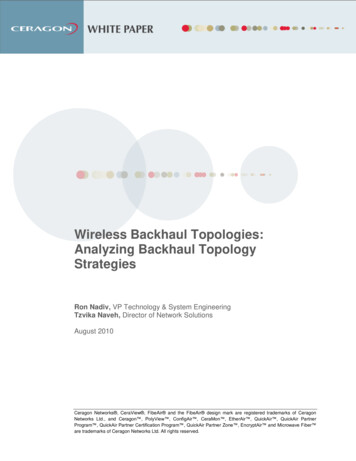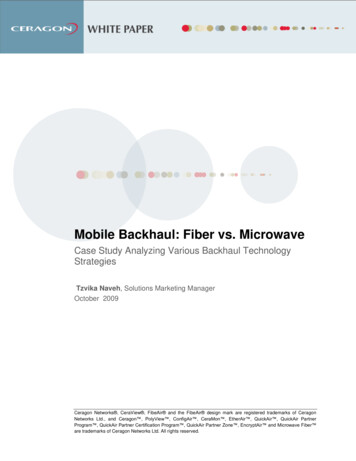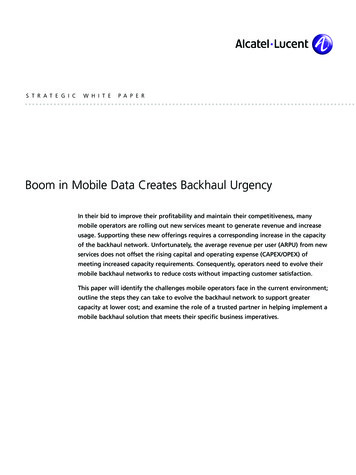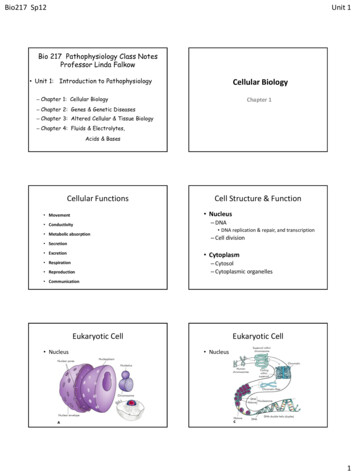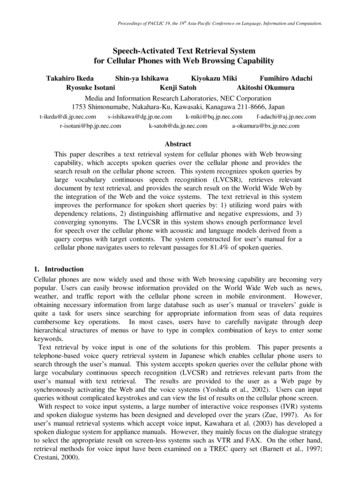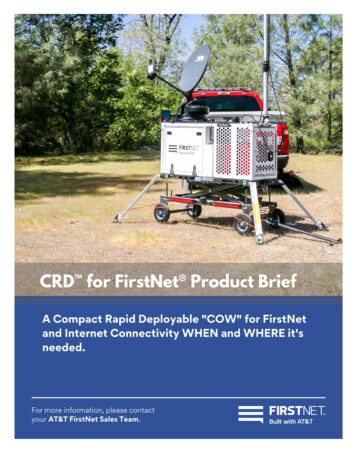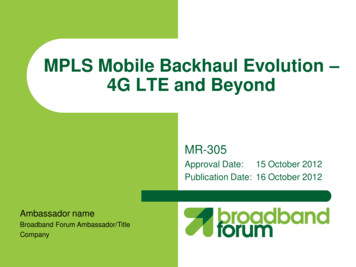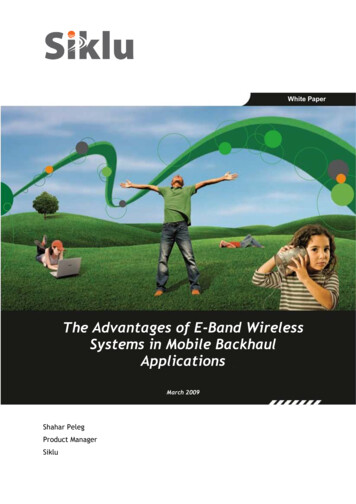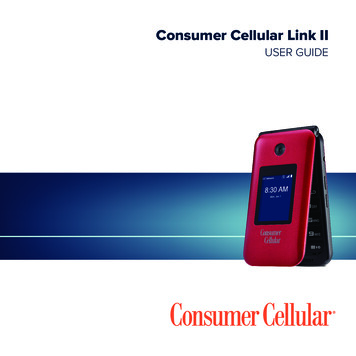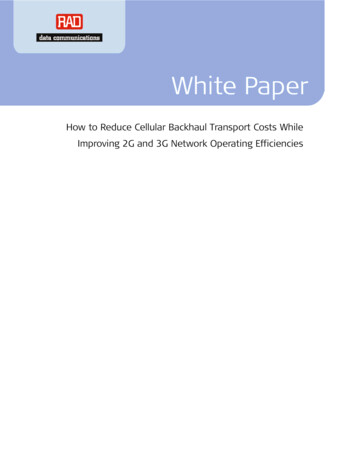
Transcription
How to Reduce Cellular Backhaul Transport Costs WhileImproving 2G and 3G Network Operating Efficiencies
White Paper: Reduce Cellular Backhaul Transport CostsContentsIntroduction .2Efficient Backhaul Design .4Any Access Network over Any Transport Network.5Backhauling over PDH/SDH Transport .6Backhauling over ATM Transport.9Backhauling over DSL Links .10Backhauling over Packet Switched Networks (PSN) – Ethernet, IP/MPLS .11Clock Distribution over the PSN .15IP-based Future .15Conclusion.16 2004 RAD Data Communications Ltd.1
White Paper: Reduce Cellular Backhaul Transport CostsIntroductionBackhaul is one of the major contributors to the high costs of building out and running amobile network. This is true whether the mobile operator owns the transport links or leaseslines from a local carrier. It also applies if the carrier is deploying a dedicated transportsegment for 3G or planning to integrate several generations into the same platform.Industry consensus indicates that transport equipment accounts for 25% of the costs ofbuilding out a private cellular backhaul infrastructure whereas, in the case of leasingservices, transport outlays vary between 40-60% of the total cost of renting lines, withbackhaul contributing 75% of this. This is compounded by the fact that the backhaul accessnetwork spans the entire coverage area. Considering the huge impact that backhaul has onoperating expenses (Opex) and capital expenses (Capex), mobile operators would be welladvised to carefully review their cellular backhaul strategies before making further networkinfrastructure investments. While prudence is always good counsel, it is particularly worthheeding during this era of rapid transition.The Challenge – Efficient Backhaul2 2004 RAD Data Communications Ltd.
White Paper: Reduce Cellular Backhaul Transport CostsComplicating the equation, network operators must now be able to support simultaneouslythe divergent technological demands and applications of existing 2G/2.5G networks as wellas those of newly emerging 3G operations. This migration from 2G circuit-switchednetworks (TDM) to 3G packet switched networks (ATM and eventually Gigabit Ethernet, IP,and MPLS) raises new challenges. In particular, the mobile network operator must weigh thecost, suitability and availability of the access platform chosen to handle the expectedincrease in bandwidth capacity and be able to manage the complexities of a convergedvoice and data network.Technologies in the Mobile Transport Network 2004 RAD Data Communications Ltd.3
White Paper: Reduce Cellular Backhaul Transport CostsEfficient Backhaul DesignBefore examining the requirements for efficient backhaul, it’s necessary to identify theelements that make up the cellular backhaul network. Backhaul is typically defined astransmitting voice and data traffic from the radio cell site to an edge switch at theingress/egress point of the backbone core network. Generally, this access network can bedivided into two segments: from the Node B (in 3G UMTS networks) or Base TransceiverStation (in 2G GSM/TDMA networks) to an aggregation point; and from the aggregationpoint to the Radio Network Controller (3G) or Base Station Controller (2G). There is a thirdsegment, between Mobile Switching Centers, which is not part of the access network but,rather, the core network, where the fundamentals of backhaul still apply.Aggregation is an essential part of the network transport design because it allows for moreefficient use of the transport bandwidth and simplifies network management. Generally,aggregation occurs where there is dense concentration of traffic from multiple radio cellsites, typically at the controller sites and the MSC. As 3G gathers steam, however, and newbroadband wireless services increase, the quantity of backhaul links will rise exponentially,making upstream aggregation at the front end of the transport network very attractive.Aggregation Nodes in the Transport Network4 2004 RAD Data Communications Ltd.
White Paper: Reduce Cellular Backhaul Transport CostsThus, there are sound business reasons for deploying aggregation devices to serve mediumsized or even smaller coverage areas. Locating a switch at a remote point-of-presence(POP) offers many economies, especially where link density is high and the price-per-portof the switching equipment justifies the investment in Capex.Traffic aggregation is applicable in two instances:1. Homogeneous traffic stream – Combining TDM links with Abis compression fromseveral BTSs over a thicker pipe enables full use of the link (fanout) or, in the caseof ATM, taking advantage of the inherent statistical multiplexing mechanism of theprotocol to reduce bandwidth.2. Heterogeneous traffic stream – Supporting different types of traffic from differentmobile generations over the same transport link leverages the existing networkinfrastructure.Any Access Network over Any Transport NetworkMobile operators are saddled with a bewildering choice of backhaul technologies andnetwork interfaces as they try to anticipate which access infrastructure will best serve theircurrent and future requirements. The easiest decision would be to build out parallelnetworks. This is not as straightforward as it would appear since the network equipmentaccess technology, which is an embedded feature provided by the cellular vendor (asdefined by industry standards), has to be considered as well as the available backhaultechnology and related services. Using a dedicated transport network for successive mobilegenerations – PDH/SDH for 2G/2.5G; ATM for UMTS Release 99; and Ethernet/IP/MPLS forUMTS revision 5/6 – is not as efficient or potentially cost-effective as integrating diversetraffic streams over a single backhaul link. Having acknowledged that, neither transmittingTDM frames nor ATM cells over an Ethernet/IP/MPLS network, nor running Ethernet/IPpackets over TDM in a cost-effective manner are trivial matters. 2004 RAD Data Communications Ltd.5
White Paper: Reduce Cellular Backhaul Transport CostsAny Access over Any Transport InfrastructureGiven the drawbacks stated above, does a converged backhaul access network solutionexist that is technologically feasible, economically sound and readily available? To find out,we’ll examine each backhaul technology and measure its suitability based on technologicaland commercial criteria.Backhauling over PDH/SDH TransportTDM-based networks – PDH and SDH/SONET – have long served as standard transportplatforms for cellular traffic. PDH and SDH/SONET are optimized to handle bulk voice circuitswith maximum uptime, minimal delay and guaranteed service continuity. Leveraging existingTDM-based networks for cellular backhaul affords a large degree of investment protectionfor operators of private networks. In addition to carrying legacy TDM streams, the TDMbased network is also suitable for ATM traffic. Thus the same TDM transport infrastructuremay be used for migration to UMTS.There are many advantages to settling on a TDM based infrastructure. The technology istime-tested, simple and deterministic – at any given time the operator knows what traffic isgoing over the links. SDH/SONET, in particular, offers incomparable reliability. TDM networksare ubiquitous, reaching even outlying rural areas. There the links tend to be underpopulated, affording economical bandwidth sharing through aggregation.6 2004 RAD Data Communications Ltd.
White Paper: Reduce Cellular Backhaul Transport CostsDespite numerous benefits, TDM does have drawbacks. UMTS uses ATM technology, whichis statistical in nature and has built-in service differentiation mechanisms. TDM is lessflexible in its support of different types of traffic. Moreover, each circuit requires adedicated timeslot, which in the long run could add to operating costs in comparison withATM’s statistical traffic handling capability. Furthermore, although the existing PDH orSDH/SONET equipment may easily support Node B’s ATM interfaces, this is not the case forIP/Ethernet. Integrating new radio network equipment may require considerableinvestments.These reservations aside, TDM-based networks can deliver significant cost reductionsproviding that the multiple traffic streams are aggregated wisely. This following illustrationshows the aggregated traffic carried as VC-12 containers over the SDH transmissionnetwork. A TDM multiplexer merges several E1 trunks, bearing either ATM or TDM traffic,over a thicker pipe. There are break-even points where moving from separate E1 lines to asingle STM-1 link becomes cost-effective. In these cases, the mobile service operator willshift from a PDH to an SDH transport network, either privately owned or leased.TDM aggregation for SDH NetworksThe business case for using SDH instead of PDH is clear-cut. Multiplexing requires fewerswitching ports and less expensive equipment. (As an example, an STM-1 port costs lessthan a 63 x E1 port card on a switch.) Also using higher speed modules allows for higherport density in the same device, further reducing Capex.Aggregation of traffic invariably leads to lower operating expenses. This holds true even foroutlying areas, accompanying lower density traffic flows. 2004 RAD Data Communications Ltd.7
White Paper: Reduce Cellular Backhaul Transport CostsNevertheless, this approach has one main drawback and that is the requirement for E1ports in the Radio Network Controller (RNC). This is because the inverse multiplexing overATM traffic (IMA) is carried over the transport network in VC-12 containers and not in anSTM-1 universal network interface (UNI) format as required by the RNC.This limitation can be overcome by channelizing the ATM traffic over the SDH network sogroups of ATM with IMA protocol are transported in VC-12 containers. The aggregatedtraffic (from multiple 2G and 3G radio sites) is transmitted in VC-12 containers across theSDH network to an ATM multiplexer, which terminates the channelized (n x VC-12) IMA cellstreams and converts them to STM-1 ATM UNI (VC-4) for RNC connectivity. Basically, tobenefit from using the same existing SDH infrastructure for both traffic types and to avoidhaving multiple E1 ports in the RNC, a dedicated device or module is required to make theconversion. What is gained by adding a dedicated device? This saves additional ports on theRNC or SDH ADM.The Channelized ApproachAggregation is also possible with a dedicated ATM device. The aggregated traffic (frommultiple 2G and 3G radio sites) is carried in VC-4 containers over the SDH transmissionnetwork. Even though we are discussing a TDM-based transport platform and mixed trafficstreams (ATM and TDM), the dedicated ATM aggregator enables the mobile networkoperator (MNO) to benefit from the ATM network’s inherent QoS and traffic engineeringmechanisms (OAM I.610) end-to-end (from aggregation point to aggregation point) acrossthe transport network. This is a significant advantage since typically the transport networkmay be leased from another operator. There are other plusses as well. Throughput is higherwith ATM (compare VC-4 bandwidth with n x VC-12) and by aggregating traffic at theremote site it is possible to apply statistical traffic handling for the variable rate flows.8 2004 RAD Data Communications Ltd.
White Paper: Reduce Cellular Backhaul Transport CostsBackhauling over ATM TransportIn the era of 3G, ATM is probably the ultimate cellular backhaul technology. Release 99 ofthe 3GPP standard denotes ATM as the de facto interface for bearing 3G traffic while GSMflows can be carried over AAL1. The protocol can cope with the multiple technologies of thevarious mobile generations, and can handle different traffic types with great efficiency. Thisis due to ATM’s built-in QoS capabilities, offering traffic prioritization and servicedifferentiation as well as traffic engineering capabilities. For example, ATM gives a mobileoperator the ability to transport voice and video streaming with fixed resources using CBRwhile adaptive traffic flows like Internet surfing or messaging can be handled with VBR.Network administration is based on ATM’s powerful (I.610) OAM mechanisms. All in all,mobile operators have greater ability to manage network operations and reduce theiroperating expenses. This extends to integration of 2G and 3G traffic flows, which is lessproblematic over a cell-based network than other networks. This also applies to supportinga future packet-based mobile access network since ATM can efficiently map Ethernet/IPover its core.Wherever an ATM network is already in place, mobile operators stand to benefitimmediately from using its powerful traffic handling features. Rolling out new infrastructurebased on ATM, however, is a different matter since the high cost of switching equipmentmay offset the Opex savings.Traffic aggregation also plays a role in reducing Opex and Capex in an ATM network.Dedicated aggregation devices, smaller in size and significantly lower in cost than ATMswitches, can be located at remote POPs or even co-located at the radio sites themselves.This equipment can minimize the number of physical links and statistical multiplexing cancontribute to reduce network-operating expenses. Furthermore, replacing low-speed portswith high-speed modules on ATM switches shaves Capex overhead. Finally, efficient, endto-end management tools improve network performance and uptime.ATM Aggregation 2004 RAD Data Communications Ltd.9
White Paper: Reduce Cellular Backhaul Transport CostsBackhauling over DSL LinksATM networks are often complemented in the Last Mile by DSL networks. That means thatthe access network is based on SHDSL and DSLAMs. Many service providers, particularly inEurope, are interested in using this popular and ubiquitous infrastructure to reduce LastMile backhaul costs.Modem-like intelligent integrated access devices (IADs) may be used to connect a GSM BTSto the DSLAM over a copper pair with a TDM IAD. Meanwhile the Node B can be linked tothe DSLAM with an ATM IAD. Traffic from the DSLAM is tunneled over the ATM transportnetwork. Both the TDM IAD and ATM IAD incorporate ATM quality of service features tomonitor and control traffic up to the Last Mile.Backhaul over DSLAM InfrastructureLeveraging the existing SHDSL infrastructure for GSM and UMTS backhaul conceivably canlead to lower access costs than traditional leased line services. The same infrastructure isalso being used for Ethernet services to corporate and enterprise customers, which meansit is suitable for Ethernet/IP interfaces and routing.The bandwidth limitations of copper are also being overcome by a technology known as DSLbonding. This is based on adding copper capacity on demand and partitioning the trafficcarried over those links. Thus the aggregated traffic from a BTS and Node B may betransported over multiple DSL links through the implementation of a bonding protocol likeIMA or M2DSL. Alternatively, bonding could be implemented in a way that is transparent tothe DSLAM and based on ML-PPP.10 2004 RAD Data Communications Ltd.
White Paper: Reduce Cellular Backhaul Transport CostsBackhauling over Packet Switched Networks (PSN) – Ethernet,IP/MPLSWhat is the advantage of using a packet switched network for cellular backhaul? Mobilenetwork planners looking for a comprehensive solution encompassing future developmentswill take a good look at the packet switched option. First, many mobile vendors are alreadyin the process of designing radio access elements with Ethernet interfaces. Second, MetroEthernet transport networks are mushrooming. Thus the trend is clearly toward apacketized network environment to handle 3G’s data-intensive services. In this scenario,the main challenge will be to deal with legacy voice and data traffic. In other words, how todeliver services based on GSM TDM and UMTS ATM equipment over an Ethernet/IPbackbone.Handling Legacy Traffic 2004 RAD Data Communications Ltd.11
White Paper: Reduce Cellular Backhaul Transport CostsTransporting TDM over Ethernet/IP is made possible by implementing TDMoIP (patented)and TDMoMPLS technologies. These protocols convey TDM circuits, mainly voiceconnections, over packet-based networks. In the case of cellular backhaul, thesetechnologies apply nicely as they are transparent to the underlying traffic. Unlike VoIP,which requires translation of signaling, TDMoIP and TDMoMPLS provide a transport tunnelacross the statistical packet network without distortion. These protocols are currently beingstandardized in the ITU, IETF, MEF and MPLS/Frame Relay Alliance.12 2004 RAD Data Communications Ltd.
White Paper: Reduce Cellular Backhaul Transport CostsOf course, TDM traffic, which is of a synchronous nature, also requires transparency ofclock regeneration. Using TDMoIP technology, the mobile network operator can aggregatetraffic from GSM base stations and connect them over the packet switched network to theBSC. The operator benefits from cost reductions associated with Ethernet/IP transport aswell from the implementation of a future-proof infrastructure. This kind of solution issuccessfully being used to transmit mobile communications over packet-based satellite andmicrowave media.2G/2.5G Traffic over PSNNo solution to handling legacy radio traffic is complete without addressing UMTS Rel.99traffic as well. The approach to this is similar to TDM. The ATM cells are transported overthe packet-switched network using a dedicated ATMoPSN device that converts ATM cellsinto packets. Once again, a central device located at the edge of the packet-basedtransport network recovers the ATM cells in their original format and feeds them to theRNC.3G ATM Traffic over PSN 2004 RAD Data Communications Ltd.13
White Paper: Reduce Cellular Backhaul Transport CostsImplementation of ATM over PSN is based on tunneling the ATM cells according to emergingIETF or ITU standards for a pseudo-wire link over a connectionless packet-based network.[The IETF standard describes the way cells are to be mapped to packets.] Proposed optionscover many-to-one (n x VCC/VPC to a single pseudo-wire) connectivity or one-to-one (asingle VCC/VPC to a single pseudo-wire) connectivity. The PSN packet can hold either asingle cell-in-frame or multiple cells-in-frame. Mapping of the ATM cells into packet flows isin accordance with the protocol’s respective addressing method: Layer 2 (MAC or MAC andVLAN addressing); Layer 2.5 (MPLS addressing); Layer 3 (IP addressing).The same procedure applies to QoS. To differentiate between flows and assure QoS in aconnectionless network, the ATM traffic class is mapped to VLANs, in the case of Ethernet;a dedicated shim header or using EXP bits in MPLS; and IP ToS/DHCP in an IP backhaulnetwork.Once the mapping or tunneling issue is resolved, the next and perhaps more challengingtask is to synchronize all network elements and distribute the clock throughout thetransport network. This is critical for maintaining proper synchronous operation of themobile network.Several clock options are available:1. Use an external reference clock based on a GPS receiver. Several mobile operatorsalready implement this solution at aggregation nodes to avoid relying on thetransport network for reference distribution. In such cases, the clock is distributedto the BTSs and Node Bs by the TDM/ATMoIP multiplexer located in the vicinity ofthe radio sites.2. Provide each radio station with a dedicated PDH link for the sole purpose ofreference distribution. In such a case, the reference would be from an accuratesource – normally an external source or higher-level SDH transport. This dedicatedclock may then be distributed by the multiplexer.14 2004 RAD Data Communications Ltd.
White Paper: Reduce Cellular Backhaul Transport Costs3. The third option is to distribute the clock via the PSN. Although this solutionpresents certain technological challenges, it would be the ideal one as long as thesynchronization requirements are met.Clock Distribution over the PSNRecovering the clock from the PSN means that the centrally located device, which normallyconnects the BNC and RNC to the packet-based transport network, will distribute adedicated reference clock together with the other traffic. To use the same stream for alllocations, the transport network must support multicasting. At the remote sites, the localTDM/ATMoIP multiplexer would recover the clock by implementing TDMoIP technology or byusing ATM nulling or adopting some other standard method.Clock Distribution over the PSNIP-based FutureIn the not so distant future, base station equipment will comport with rev.5 and rev.6,dictating an IP-based access interface. Then the issue will arise as to how to run this trafficover “legacy” networks. Solutions currently exist for supporting MLPPP over PDH, virtualconcatenation with LCAS for SDH networks and AAL5 in the case of ATM. 2004 RAD Data Communications Ltd.15
White Paper: Reduce Cellular Backhaul Transport CostsConclusionThere is no widely accepted blueprint or off-the-shelf solution for designing today’s cellularbackhaul network. A prudent, forward looking cellular backhaul strategy must take intoaccount current voice requirements and limited data traffic while minimizing networkoperating expenses or capital equipment outlays. Yet it must also be able to factor in futurebroadband services, which will eventually encompass multimedia imaging, broadcast videoand video conferencing. Despite the challenges, the mobile network operator has plenty ofoptions available: Leasing or owning the transport network Leveraging the 2G infrastructure Building out backhaul from scratch Using copper, fiber or microwave Providing end-to-end QoS over the transport network Maintaining 2G and 3G simultaneouslyThe key to success is in choosing a suite of network components with the flexibility andprice/performance characteristics that enable the mobile network operator to pursue allavailable options and implement those which best address present and future technologicaland commercial concerns.16 2004 RAD Data Communications Ltd.
White Paper: Reduce Cellular Backhaul Transport Costs
shift from a PDH to an SDH transport network, either privately owned or leased. TDM aggregation for SDH Networks The business case for using SDH instead of PDH is clear-cut. Multiplexing requires fewer switching ports and less expensive equipment. (As an example, an STM-1 port costs less than a 63 x E1 port card on a switch.)
